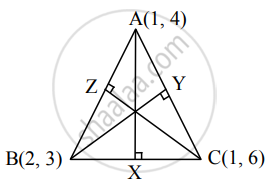Advertisements
Advertisements
प्रश्न
Answer the following question:
The vertices of a triangle are A(1, 4), B(2, 3) and C(1, 6) Find equations of altitudes of ∆ABC
उत्तर

Let AX, BY and CZ be the altitudes through the vertices A, B and C respectively of ∆ABC.
Slope of BC = – 3
∴ Slope of AX = `1/3` ...[∵ AX ⊥ BC]
Since altitude AX passes through (1, 4) and has slope `1/3`,
equation of altitude AX is
y – 4 = `1/3(x - 1)`
∴ 3y – 12 = x – 1
∴ x – 3y + 11 = 0
Since both the points A and C have same x co-ordinates i.e. 1,
the points A and C lie on the line x = 1.
AC is parallel to Y-axis and therefore, altitude
BY is parallel to X-axis
Since the altitude BY passes through B(2, 3),
the equation of altitude BY is y = 3.
Also, slope of AB = – 1
∴ Slope of CZ = 1
Since altitude CZ passes through (1, 6) and has slope 1,
equation of altitude CZ is
y – 6 = 1(x – 1)
∴ x – y + 5 = 0
APPEARS IN
संबंधित प्रश्न
Obtain the equation of the line :
parallel to the X−axis and making an intercept of 3 unit on the Y−axis
Obtain the equation of the line containing the point :
B(4, –3) and parallel to the X-axis
Find the equation of the line passing through the origin and parallel to AB, where A is (2, 4) and B is (1, 7)
Find the equation of the line having slope `1/2` and containing the point (3, −2).
Find the equation of the line containing point A(4, 3) and having inclination 120°
Line y = mx + c passes through points A(2, 1) and B(3, 2). Determine m and c.
The vertices of a triangle are A(3, 4), B(2, 0), and C(−1, 6). Find the equation of the line containing the midpoints of sides AB and BC
Find the x and y intercept of the following line:
`x/3 + y/2` = 1
Find the x and y intercept of the following line:
`(3x)/2 + (2y)/3` = 1
Find equations of lines containing the point A(3, 4) and making equal intercepts on the co-ordinates axes.
Find equations of altitudes of the triangle whose vertices are A(2, 5), B(6, –1) and C(–4, –3).
Find the equations of perpendicular bisectors of sides of the triangle whose vertices are P(−1, 8), Q(4, −2), and R(−5, −3)
N(3, −4) is the foot of the perpendicular drawn from the origin to line L. Find the equation of line L.
Select the correct option from the given alternatives:
If the point (1, 1) lies on the line passing through the points (a, 0) and (0, b), then `1/"a" + 1/"b"` =
Select the correct option from the given alternatives:
The equation of the line through (1, 2), which makes equal intercepts on the axes, is
Answer the following question:
Does point A(2, 3) lie on the line 3x + 2y – 6 = 0? Give reason.
Answer the following question:
Obtain the equation of the line containing the point (2, 4) and perpendicular to the Y−axis
Answer the following question:
Find the equation of the line through the origin which bisects the portion of the line 3x + 2y = 2 intercepted between the co−ordinate axes.
Answer the following question:
The vertices of a triangle are A(1, 4), B(2, 3) and C(1, 6). Find equations of the sides.
Answer the following question:
Find the equation of the line through A(−2, 3) and perpendicular to the line through S(1, 2) and T(2, 5)
Answer the following question:
Find the X−intercept of the line whose slope is 3 and which makes intercept 4 on the Y−axis
Answer the following question:
Find the Y-intercept of the line whose slope is 4 and which has X intercept 5
Answer the following question:
A(1, 4), B(2, 3) and C(1, 6) are vertices of ∆ABC. Find the equation of the altitude through B and hence find the co-ordinates of the point where this altitude cuts the side AC of ∆ABC.
Answer the following question:
A line perpendicular to segment joining A(1, 0) and B(2, 3) divides it internally in the ratio 1 : 2. Find the equation of the line.
Answer the following question:
P(a, b) is the mid point of a line segment between axes. Show that the equation of the line is `x/"a" + y/"b"` = 2
Answer the following question:
Show that there is only one line which passes through B(5, 5) and the sum of whose intercept is zero.
If the equation kxy + 5x + 3y + 2 = 0 represents a pair of lines, then k = ____________.
A Plane cuts the coordinate axes X, Y, Z at A, B, C respectively such that the centroid of the Δ ABC is (6, 6, 3). Then the equation of that plane is ______.
The angle between the lines x sin 60° + y cos 60° = 5 and x sin 30° + y cos 30° = 7 is ______
Suppose the line `(x - 2)/α = ("y" - 2)/(-5) = ("z" + 2)/2` lies on the plane x + 3y – 2z + β = 0. Then (α + β) is equal to ______.
Let the perpendiculars from any point on the line 7x + 56y = 0 upon 3x + 4y = 0 and 5x – 12y = 0 be p and p', then ______.
Area of the parallelogram formed by the lines y = mx, y = mx + 1, y = nx and y = nx + 1 is equal to ______.
